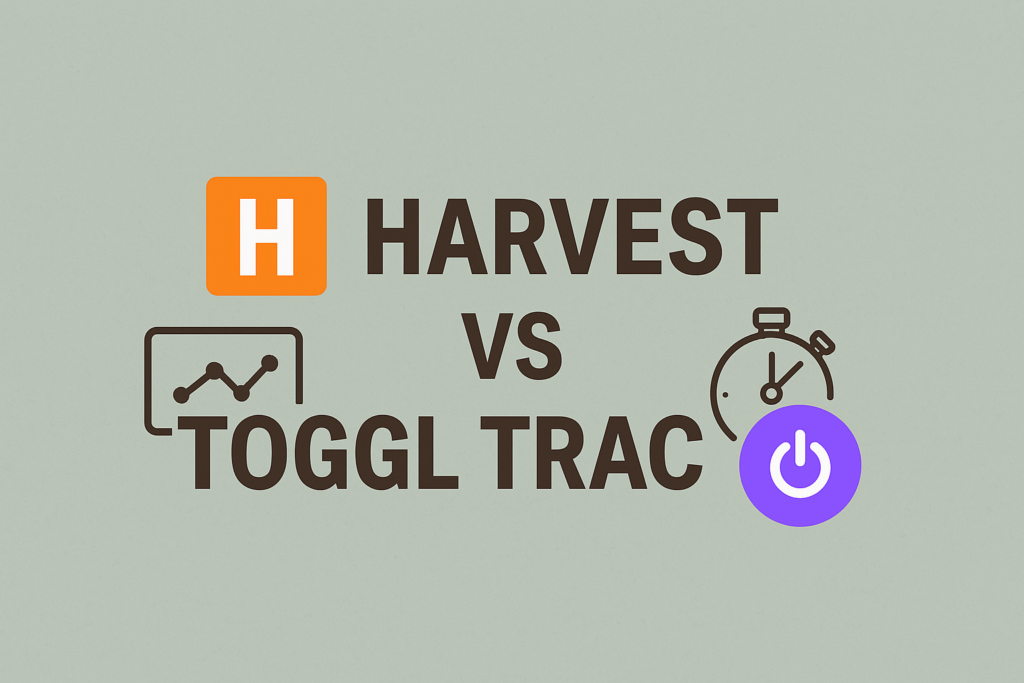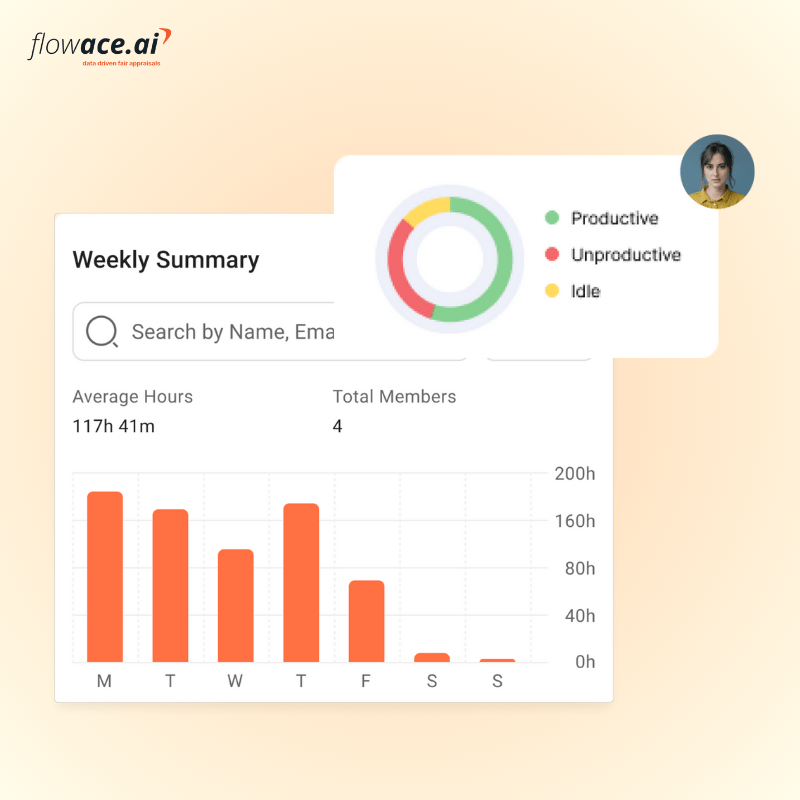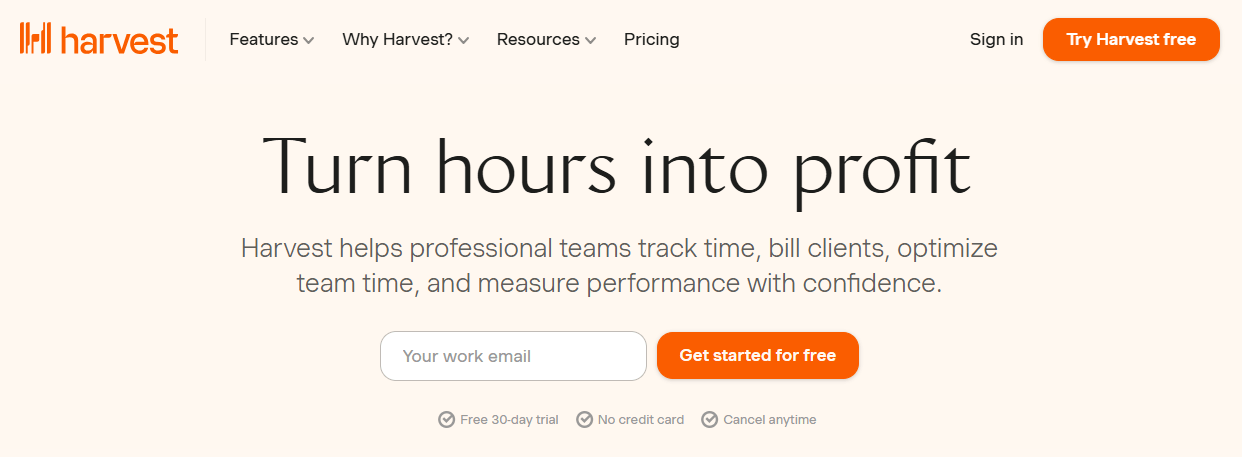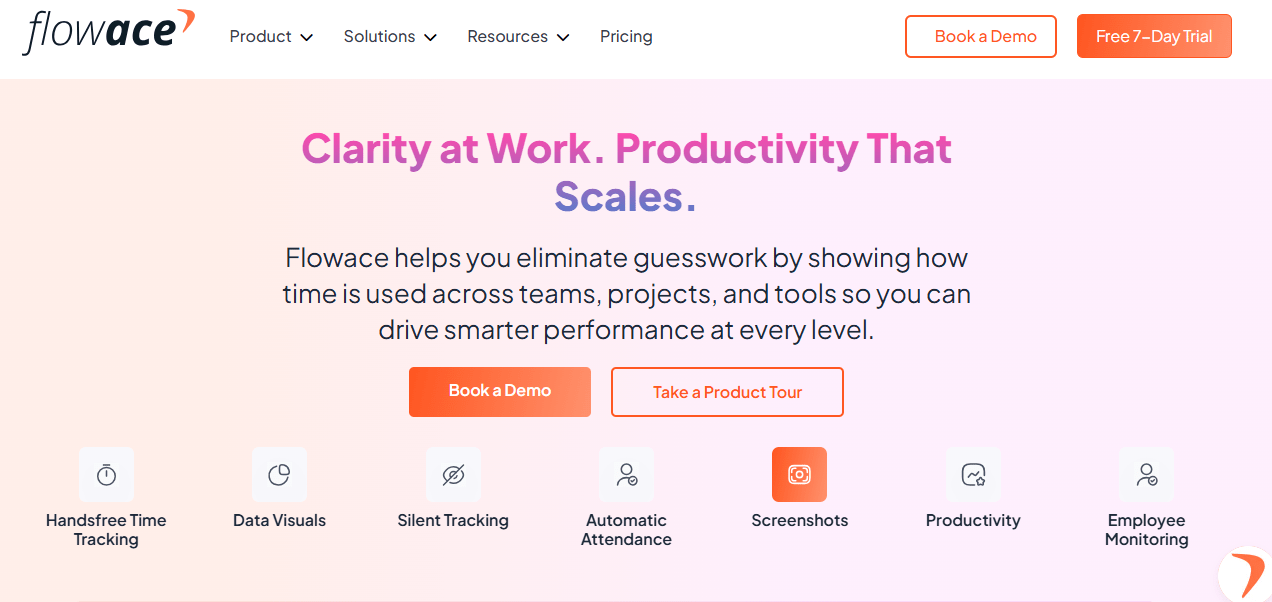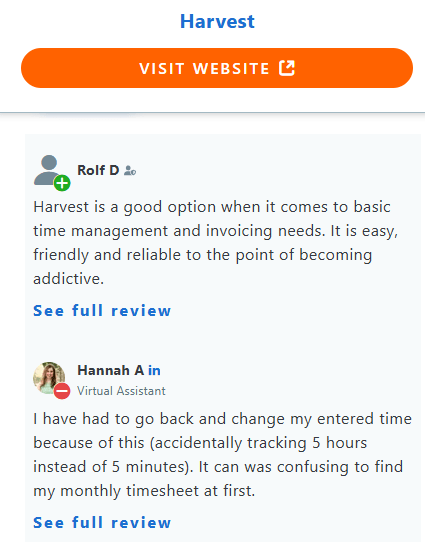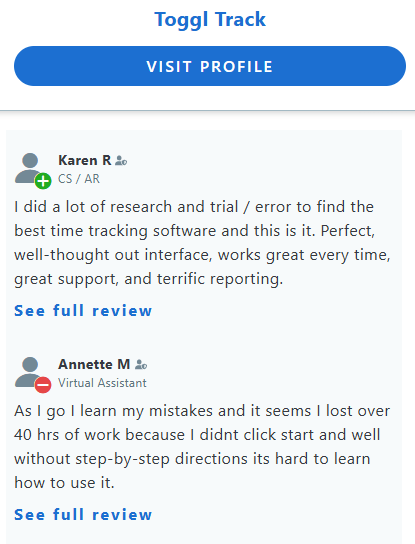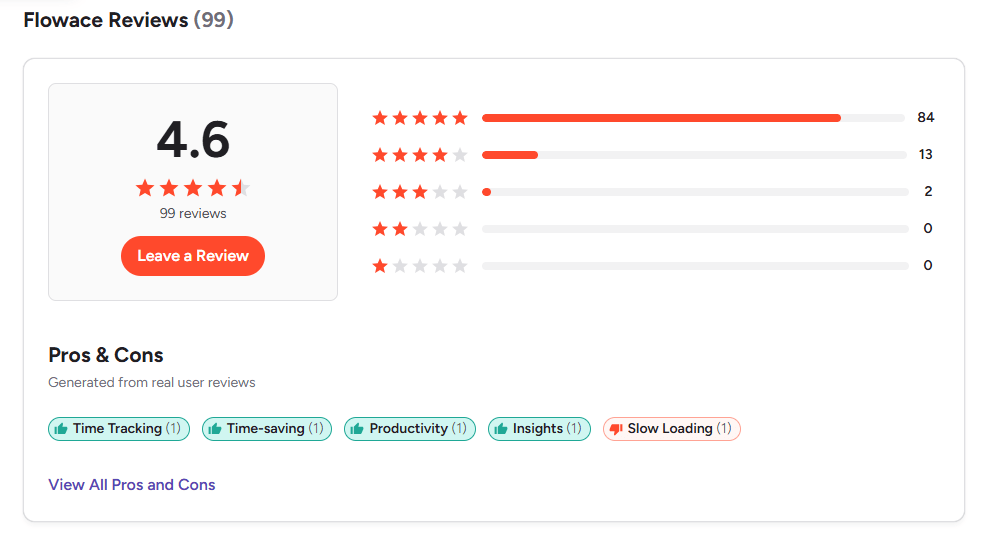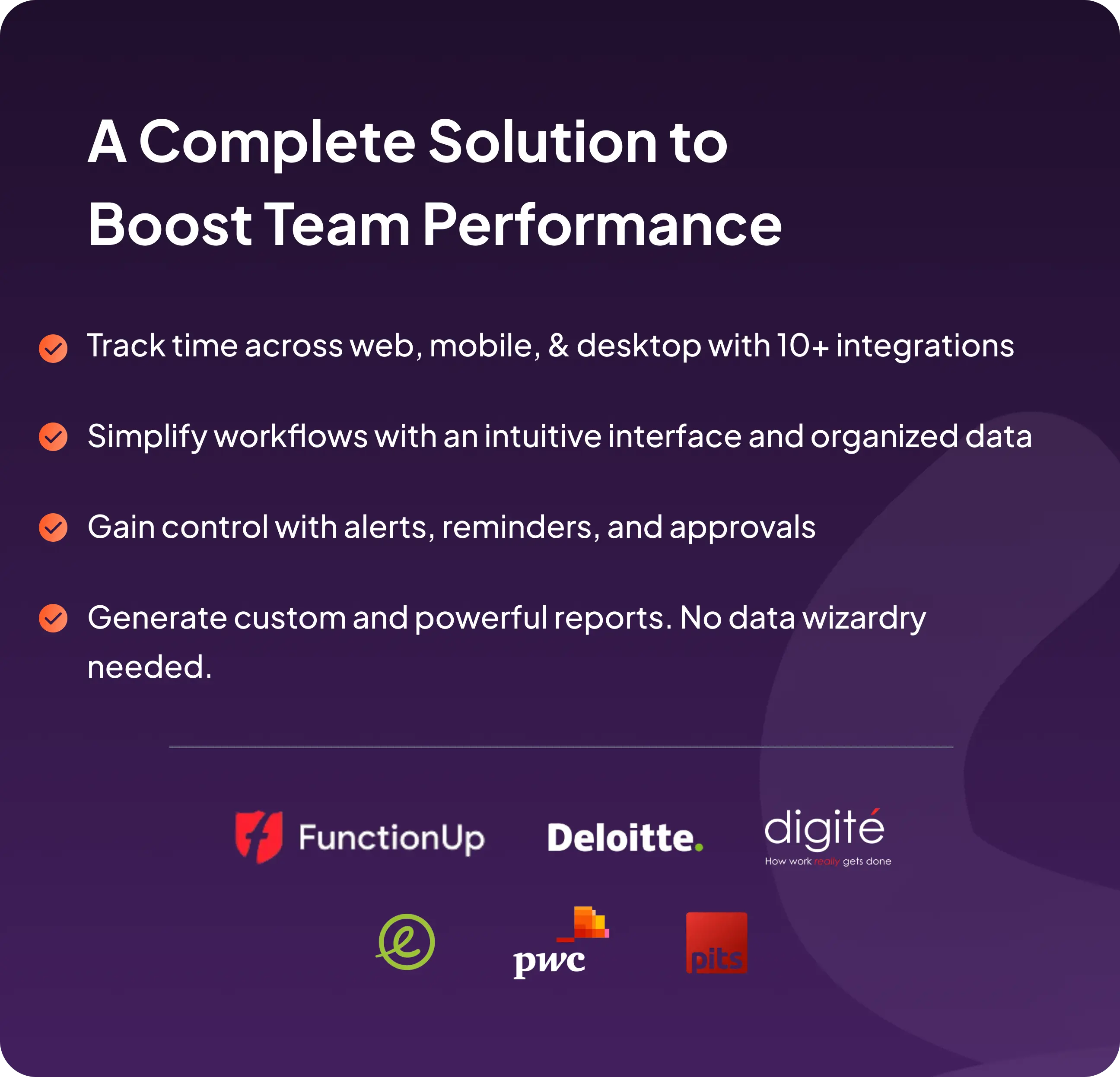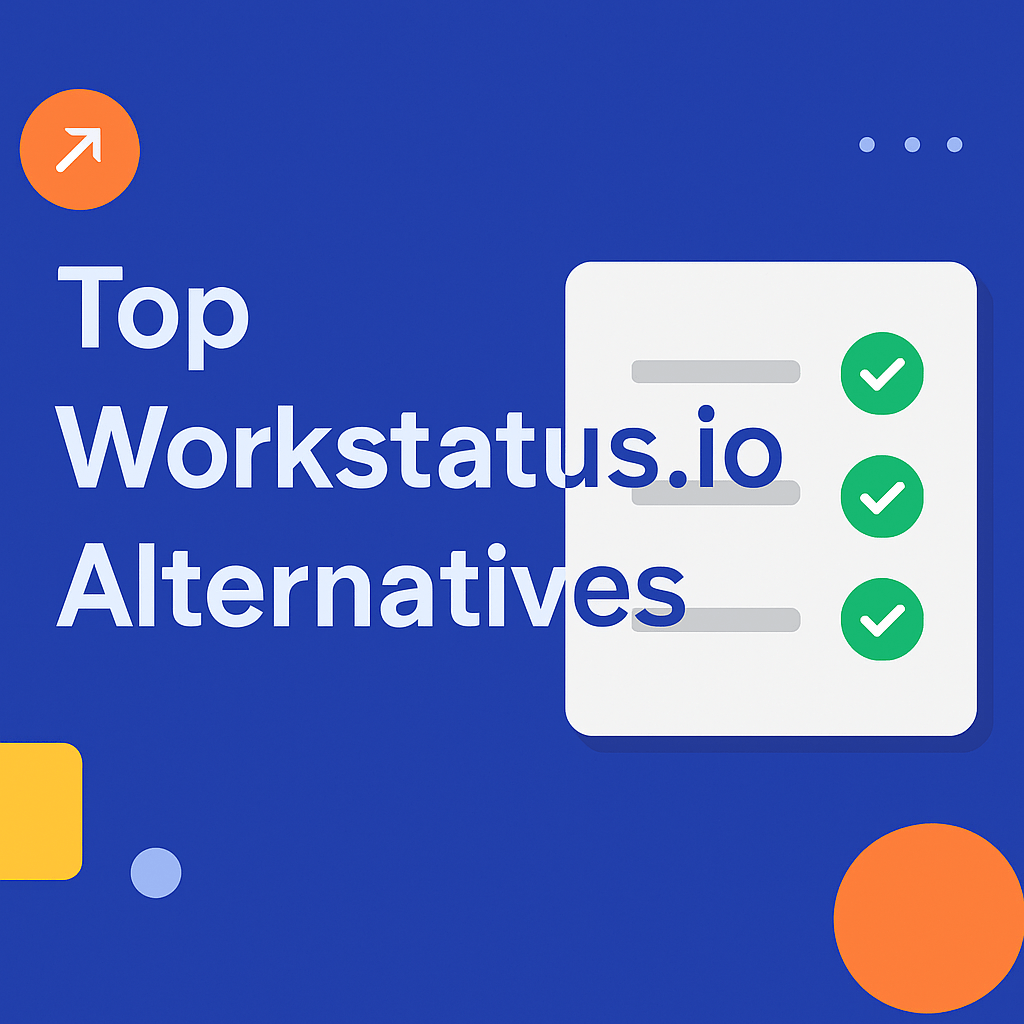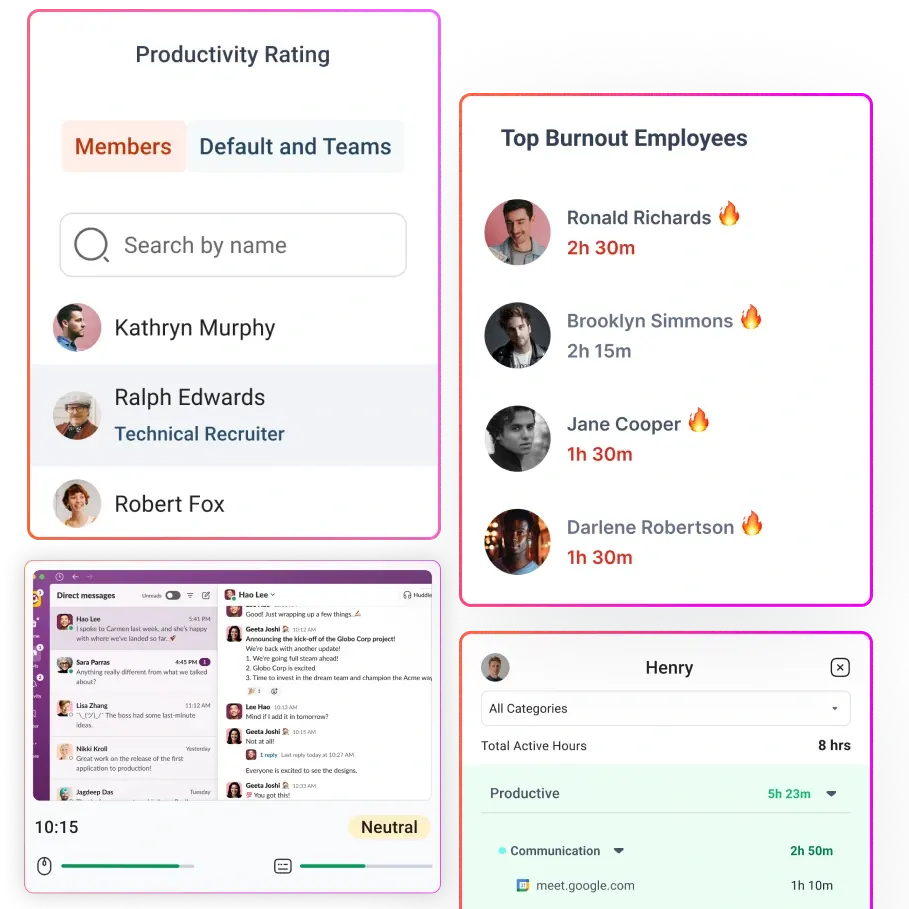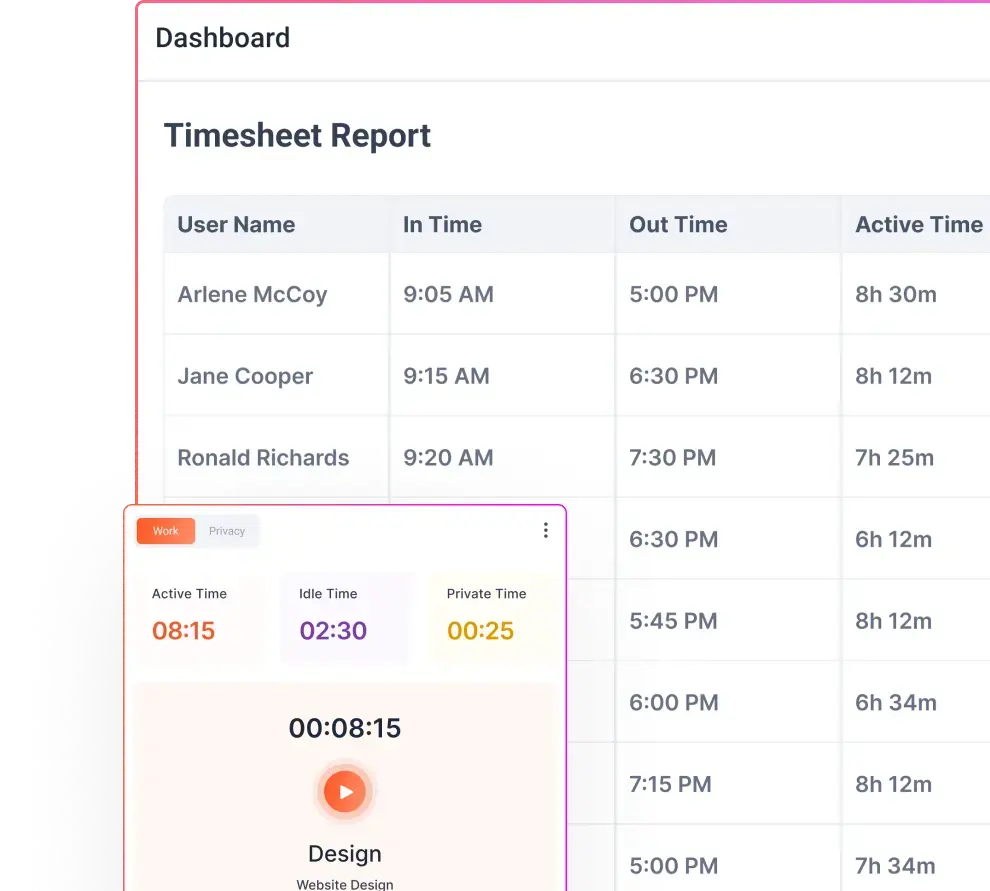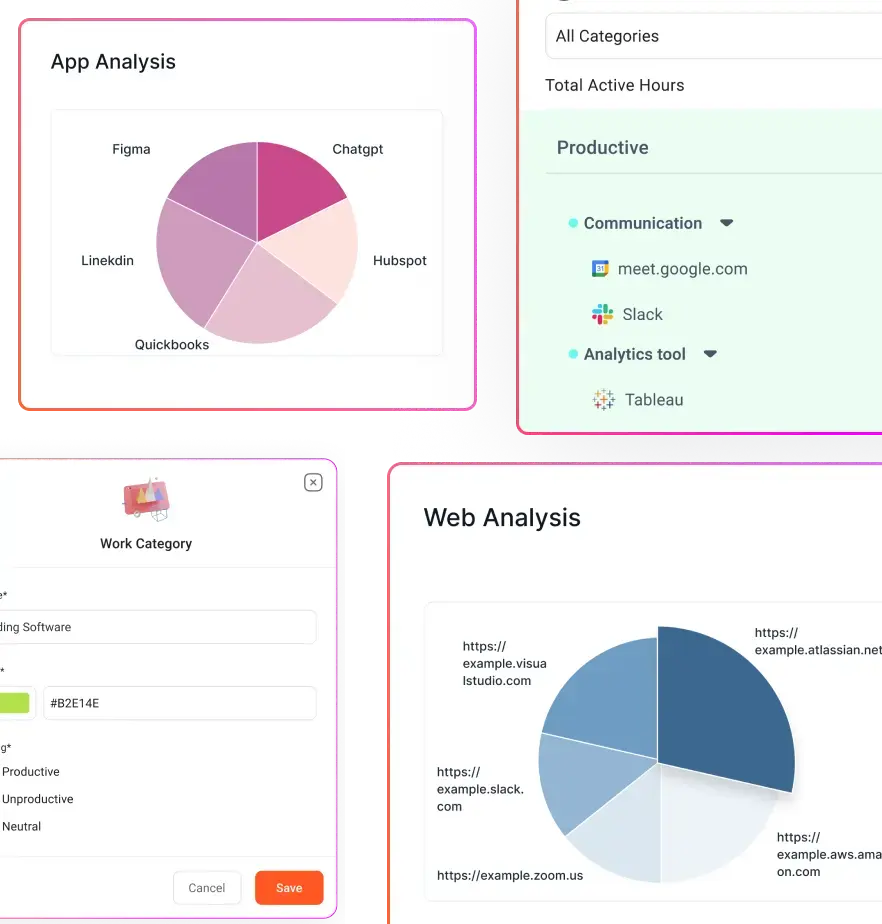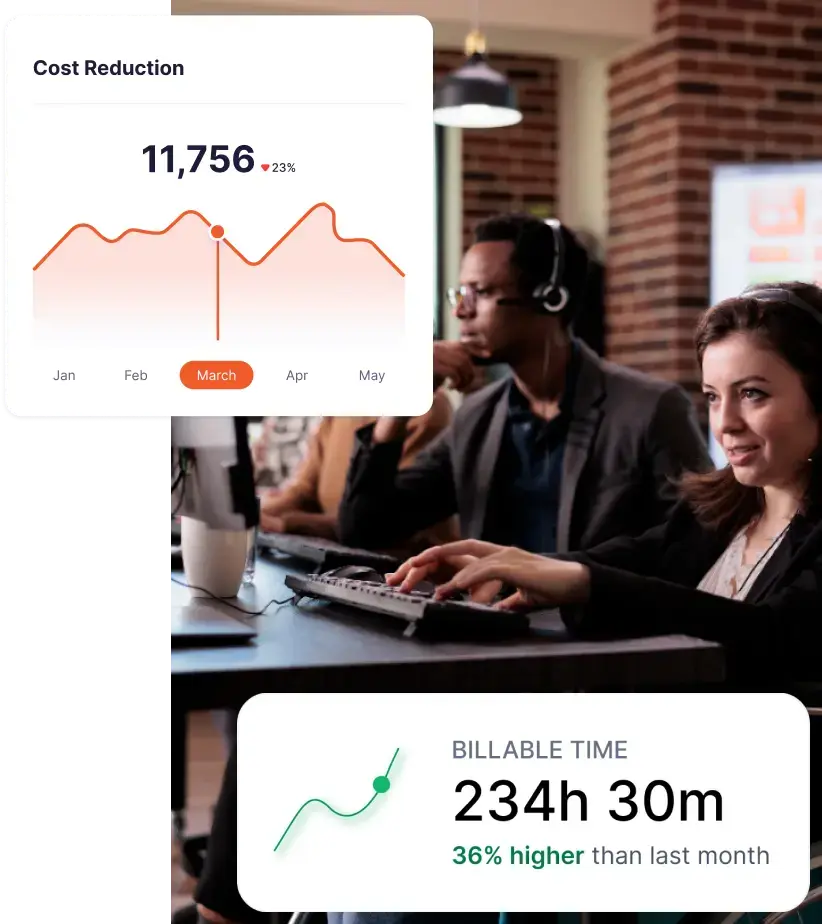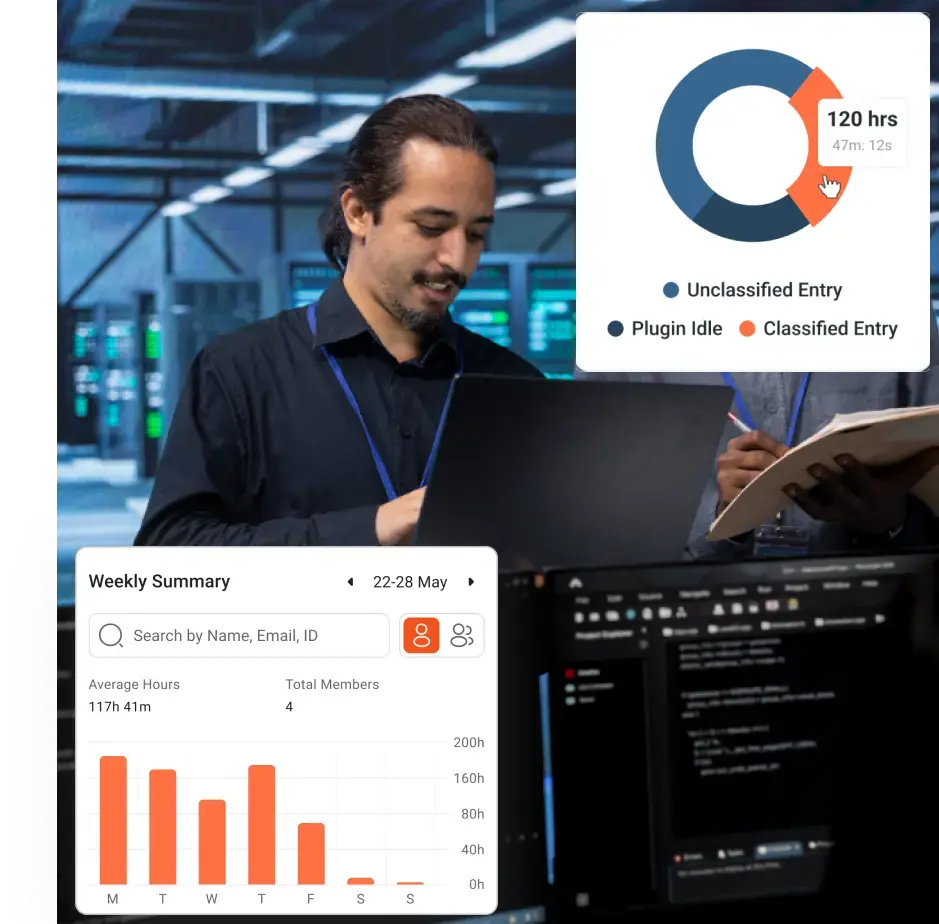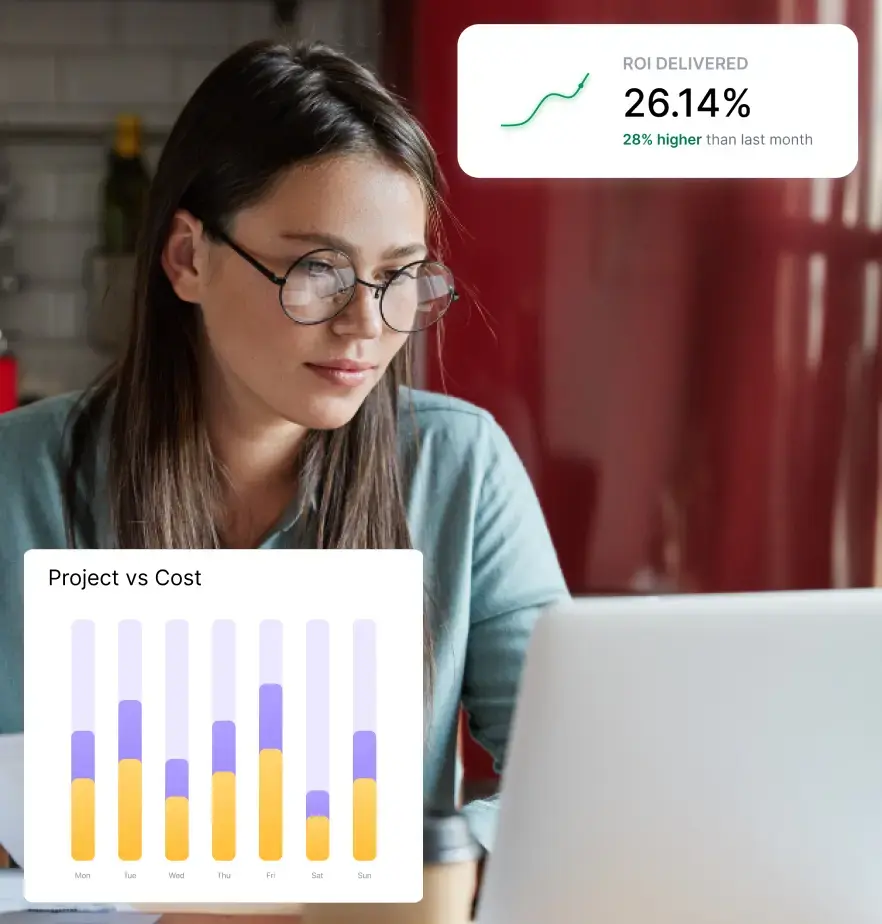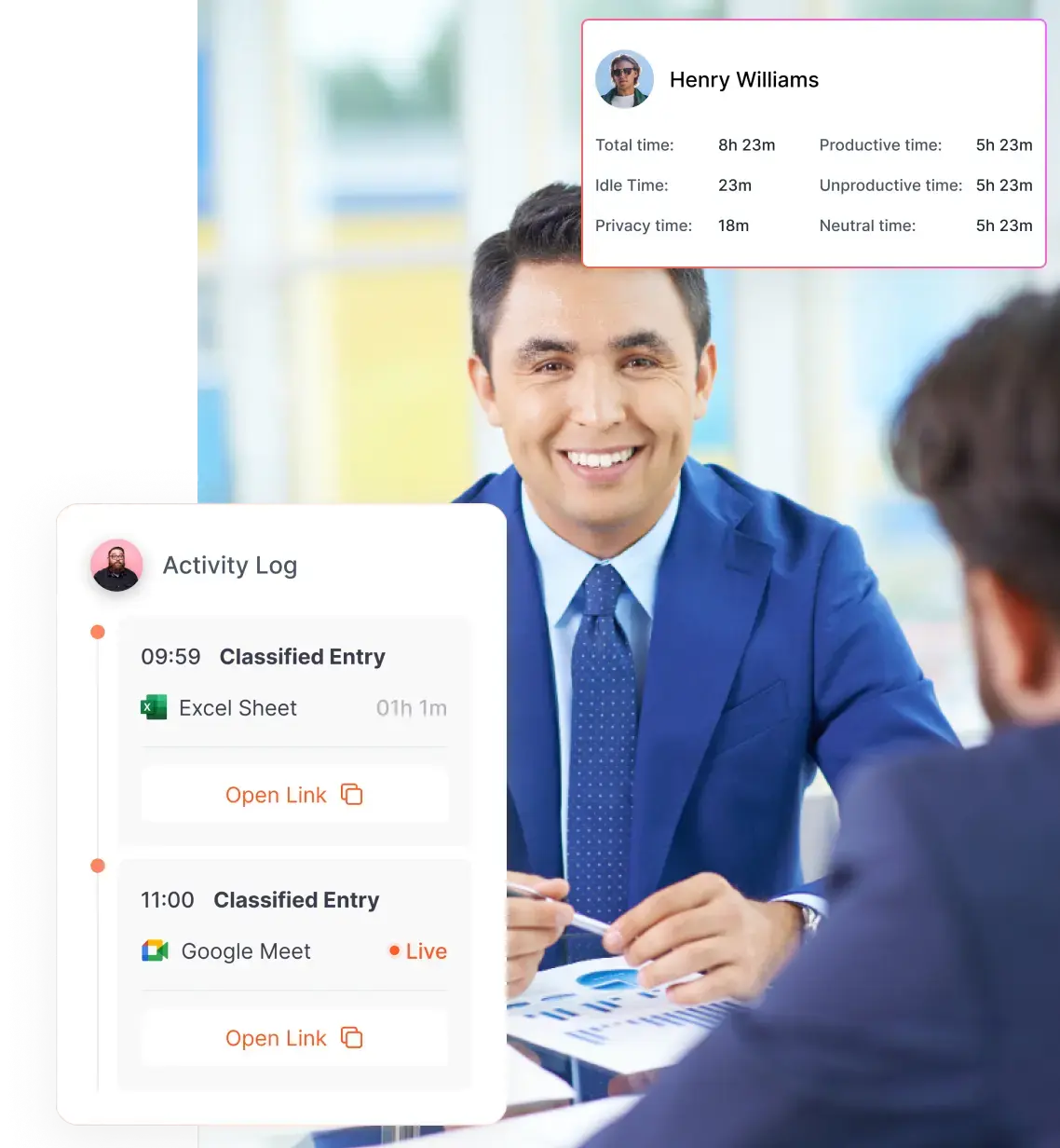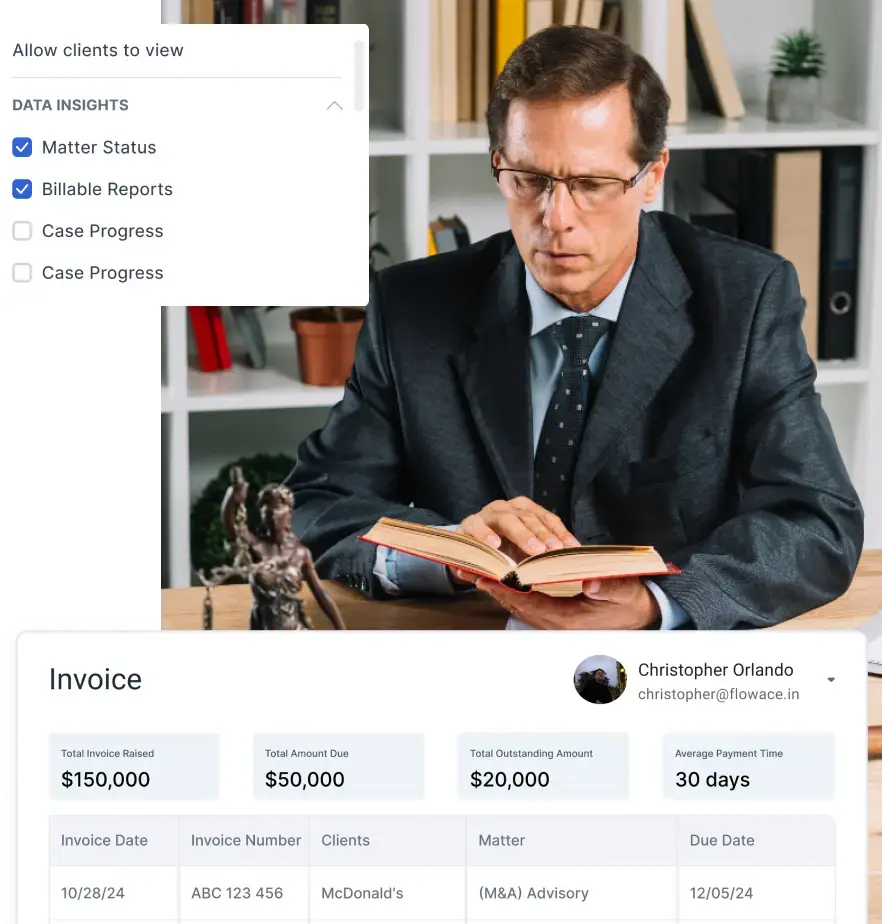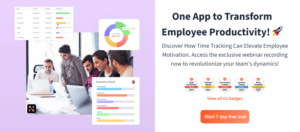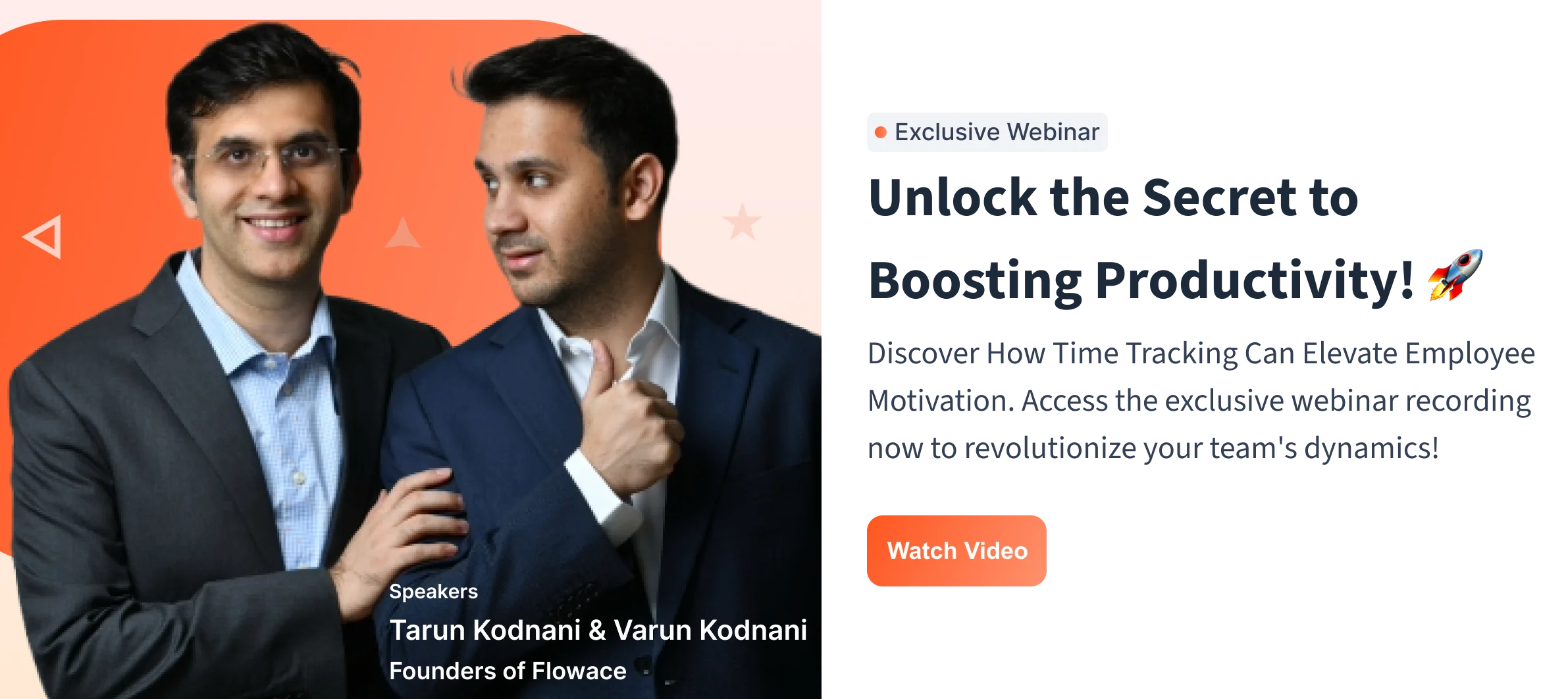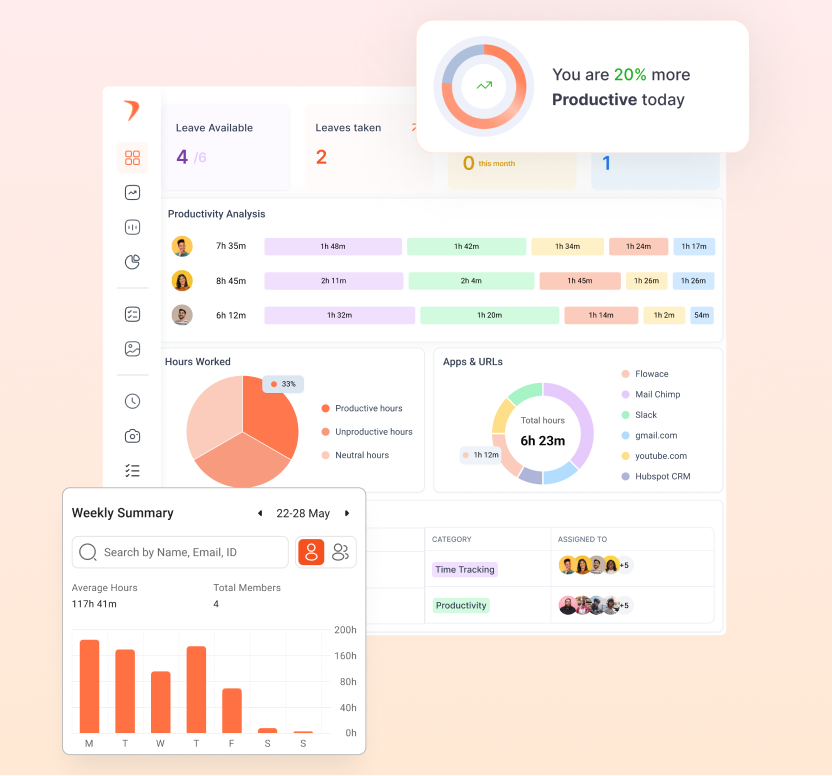When it comes to tracking your work hours, Harvest vs Toggl Track is a matchup you’ve likely considered. Both are popular time tracking tools used by freelancers, business owners, and remote teams all over the world.
But which one is right for you?
In this article, we’ll examine how Harvest and Toggl Track compare in important categories, including usability, cost, invoicing, integrations, analytics, and ideal use cases.
We’ll also introduce you to Flowace, an AI-powered substitute that offers automated time tracking, better team monitoring, and improved reporting to the table.
Key Takeaways:
-
Harvest is simple but manual – It’s ideal for freelancers who want built-in invoicing, project budgeting, and an easy-to-use interface, but it lacks automation, GPS tracking, and advanced productivity monitoring.
-
Toggl Track is flexible and visual – It offers semi-automated tracking (via triggers), clean dashboards, and a generous free plan, but it doesn’t support invoicing or detailed monitoring, and it depends heavily on user input.
-
Flowace is fully automated and AI-powered – Unlike Harvest and Toggl, Flowace runs in the background, tracking time automatically across apps, websites, and calls—no need to hit “Start” or remember to log hours.
-
Flowace offers deeper productivity insights – With AI-generated analytics, Flowace helps teams understand work habits, identify bottlenecks, and improve focus, all without micromanaging.
-
Great for remote and hybrid teams – Flowace includes ethical employee monitoring, GPS tracking, call logs, and silent screenshot capture, making it ideal for distributed teams in IT, BPOs, and agencies.
-
Affordable at scale – Flowace starts at just $2.99/user/month, making it significantly cheaper than Harvest ($11/user) and Toggl Track Premium ($18/user), especially for growing teams.
-
Try before you buy – With a free trial and minimal setup, Flowace is an easy upgrade for any team tired of manual tracking or missing insights.
Why Time Tracking Matters for Everyone
Time tracking isn’t just corporate jargon. As a freelancer, you need accurate time logs to bill clients fairly and see which projects are consuming most of your day. For business owners, time tracking helps gauge productivity, manage project budgets, and ensure no billable hour slips through the cracks. And if you work remotely, tracking your hours brings transparency and accountability.
In fact, using a solid time tracking tool can motivate you to organize your day better. It gives you a clear picture of where your time is going. You might realize you’re spending too much time on meetings and not enough on deep work. Or maybe you’re over-delivering on projects without getting paid for all the extra hours.
So, whether you’re a solo freelancer trying to keep your work-life balance in check or a CEO managing a distributed team, time tracking matters.
What is Harvest?
Harvest is a cloud-based time tracking tool that’s great for both logging your hours and managing client billing. Think of it as a timesheet template that also acts as your billing assistant. Since its launch in 2006, Harvest has become a mature platform, used by teams of all sizes. It allows you to start and stop timers as you work, or simply enter your hours into a timesheet at the end of the day.
But Harvest isn’t just about tracking time. It also offers invoicing, expense tracking, and basic project management features, all in one place. This makes it easy to manage projects, keep track of your expenses, and get paid for your time.
The interface is simple and centers around projects, tasks, and clients. Harvest’s goal is to make time tracking and client billing as seamless as possible.
What is Toggl Track?
Toggl Track is a user-friendly time tracking app known for its simplicity. It’s part of the Toggl suite (along with Toggl Plan and Toggl Hire), but today, we’re focusing just on Toggl Track. This app helps individuals and small teams log their hours quickly.
The main selling point of Toggl Track is its ease of use. You can start a timer with just one click, and you don’t have to worry about project details right away. You can always fill them in later. Toggl gives you a clean web dashboard and handy apps for Windows, Mac, Linux, iOS, and Android, meaning you can track time from just about any device.
What is Flowace?
Flowace is a smart, AI-powered time tracking tool that automates the whole process. It is a smart assistant that tracks time for you without the need for you to manually start and stop timers.
Flowace uses artificial intelligence to automatically track and analyze your work hours. Whether your team is remote, in-office, or hybrid, Flowace can handle it. It works in the background, monitoring app and website usage, logging meeting durations, tracking phone call time, and even capturing screenshots (in a “silent mode” if you prefer).
The goal of Flowace is to give you and your team a clear picture of what’s going on without the extra effort. This tool helps managers see who’s working, when they’re working, and what they’re working on. It’s like having a personal productivity assistant that runs quietly in the background.
Flowace positions itself as a robust time tracking tool. It is also a good alternative for tools like Time Champ, Teramind, Time Doctor etc.
Harvest vs Toggl Track vs Flowace: Feature Comparison
Let’s get down to business. Let’s compare Harvest vs Toggl vs Flowace head-to-head, to see how they handle time tracking. Each tool has its own way of doing things, from manual timers to full automation. By the end, you’ll know which one fits your workflow best.
Harvest vs Toggl Track vs Flowace: Time Tracking Methods
Harvest
Harvest is all about traditional time tracking. You hit “Start” when you begin a task and “Stop” when you’re done. If you forget, you can manually enter your hours later or even fill out a whole week’s worth of time in one go.
Harvest also has idle detection, so if you step away from your desk for too long, it asks if you want to keep or remove that idle time. It’s a nice safeguard against tracking hours you didn’t actually work.
Harvest’s philosophy is to make time tracking and client billing as seamless as possible. With apps available for desktop and mobile, and even a browser extension, Harvest lets you track time from pretty much anywhere.
Toggl Track
Toggl offers the same manual timer approach with a little something extra. Like Harvest, you can create a task or project and click a big friendly “Start” button to begin logging time. Toggl also gives you the option to type in entries after the fact. Where Toggl Track pulls ahead is with its Autotracker feature for automated tracking. This optional feature can be set up to watch for certain applications or keywords.
For example, you can have Toggl automatically start timing when you open Photoshop or your coding IDE. It’s not AI-powered, but it’s a clever trigger system that saves you from forgetting to start a timer. Toggl also has idle time detection and even a Pomodoro timer mode to encourage you to take breaks.
So Toggl’s time tracking methods range from fully manual to semi-automatic. It caters to both disciplined timekeepers and the more forgetful among us.
Flowace
Flowace takes time tracking to the next level with its fully automated system. You don’t start or stop timers at all. Flowace runs in the background, quietly recording your work activity. It tracks which apps and websites are in use, for how long, and can even log specific details like call durations or meeting times.
Essentially, Flowace is always on, capturing your productive and not-so-productive moments throughout the day.
The level of automation in Flowace ensures that every minute is accounted for, without relying on human memory. It’s ideal for teams who find manual timers tedious or for managers who want a complete record of work hours.
Harvest vs Toggl Track vs Flowace: Invoicing & Payments
Harvest
Harvest can automatically convert tracked hours and expenses into professional invoices. After you track time to a project, you can pull those billable hours into an invoice, add any expenses, and send it off to your client. It even integrates with Stripe and PayPal, so you can accept online payments directly from the invoice link.
Harvest makes it easy to see which invoices have been paid and which are still open, and it can send automatic payment reminders to clients. If you freelance or run an agency, this means less jumping between a time tracker and an accounting tool
Toggl Track
Toggl Track, by contrast, does not have a built-in invoicing module. It focuses on time data, though it gives you features to support an invoicing process.
With Toggl, you can tag your hours as billable or non-billable and set billable rates for different projects or team members. Toggl’s reports will show billable amounts, and you can compare them against labor costs (payroll) to see profitability.
However, when it’s time to invoice the client, Toggl offers a blank invoice template (PDF) that you can fill in with your Toggl data. It’s basically a downloadable form where you plug in the hours and rates from Toggl’s report.
Flowace
Flowace can ensure you have accurate data for billing. You can easily see how many hours were spent on a client project and use that to create invoices in your billing software. Flowace doesn’t currently generate client invoices, but you can use the data for payroll and billing.
Flowace also automates call tracking and generates invoice entries for client calls, based on call duration and context.
Flowace will log those call times and could help create an invoice line item for you. So while Flowace won’t email your client an invoice, it plays nice with the invoicing process.
Harvest vs Toggl Track vs Flowace: Project Management
Harvest
Harvest isn’t a full-fledged project management (PM) tool. But, it does provide features to monitor project progress from a time and budget perspective. Essentially, Harvest turns your timesheet data into simple project reports.
You can set up projects in Harvest with hourly budgets or fee budgets. As your team logs time, you’ll see how much of the budget is used up. Harvest’s reports show you the total hours tracked per project, the costs incurred, and how that compares to your budget limits.
It’s great for a high-level view. For example, you might see that Project X is 80% done in terms of hours logged, or that you’ve burned through 50% of the budget in billable hours
To sum up, Harvest offers basic project tracking via time and budget reports. It gives you enough insight to make decisions and keep clients updated.
Toggl Track
Toggl also isn’t a full project management app. But it offers a Project Dashboard and some neat features to oversee projects from a time perspective. In Toggl, you can organize your tracked time by projects and clients, and then use the dashboard to get an overview of all projects at once
Toggl’s project dashboard shows total time spent on each project and how it compares to any estimated time or budget you set. It even has a feature where you get alerts when a project’s tracked hours approach a certain threshold of the estimate.
Like Harvest, Toggl doesn’t handle task assignments or dependencies. It focuses on the time dimension. Toggl also allows adding notes or descriptions to time entries, which can serve as mini status updates on what was done.
Overall, Toggl’s project tracking features are slightly more dynamic, with real-time dashboards and alerts that many managers appreciate.
Flowace
Flowace approaches project management from a productivity lens. It automatically tracks where your time is spent. You can categorize that time under projects or tasks, often by setting up rules or through integration with project management tools.
On its own, Flowace will show you detailed breakdowns of how time was allocated. For example, hours spent on Project X vs Project Y, or even time spent in different apps for a project. This can complement your project management process by providing actual data on how long tasks take.
Flowace doesn’t have kanban boards or Gantt charts, but it ensures that the time aspect of project management is thoroughly captured. Also, because it can monitor activity levels, Flowace might indicate if a project is getting stalled (e.g., very little activity logged over a few days) or if certain tasks are consuming unexpectedly large chunks of time.
If you use Jira, Asana, or other PM tools, Flowace can integrate with them to synchronize project and task names, making it easy to attribute tracked time to the right bucket.
In summary, Flowace fits into project management by feeding you rich time and productivity data, whereas Harvest and Toggl provide simpler project-level summaries from the time you manually log.
Harvest vs Toggl Track vs Flowace: Integrations
Harvest
Harvest plays well with others and offers 70+ integrations with popular work apps. These include project management tools like Asana, Trello, and Jira; communication tools like Slack; and accounting tools like QuickBooks and Xero.
Harvest also connects with reporting and analytics apps. For eg: it can feed data to Google Sheets or business intelligence dashboards. And it integrates with online payment gateways to streamline payments.
Toggl Track
Toggl Track boasts 100+ integrations with third-party apps. Toggl’s integrations often work via the Toggl Button (a browser extension) that embeds a timer button into other apps. You’ll find Toggl integrated with project management tools, development tools, Google Workspace apps, Calendars, and more.
It also integrates with CRM systems like Salesforce and HubSpot, and even with support tools like Zendesk. This broad integration support means you can start a Toggl timer from almost anywhere and pull the context (project, task name) along with it.
Flowace
Flowace integrates with major project management and collaboration platforms such as Jira, Asana, Salesforce, and others. This allows it to import project structures or send data to those systems.
For example, you could integrate Flowace with Jira to automatically log work hours to Jira tickets based on Flowace’s tracking.
Flowace also provides integration for calendar apps, which can help correlate meetings or events with your time logs.
Flowace’s focus is on integrating with the tools that matter for productivity and time management. It’s likely that its integration list is growing, given its aim to be an all-in-one productivity companion. And because Flowace captures so much data automatically, even with a few integrations you can get a lot of value.
Harvest vs Toggl Track vs Flowace: Best Use Cases
So, which scenarios are Harvest, Toggl Track, and Flowace each best suited for? Each tool has its sweet spot.
Harvest
Harvest is ideal for businesses and freelancers who need time tracking tightly integrated with billing. If your workflow involves logging hours and then invoicing clients for those hours, Harvest can save you a ton of effort. It’s also great for small teams that want an easy way to track multiple projects and keep an eye on project budgets and billable vs non-billable time. But, if you require advanced productivity monitoring or a super-detailed breakdown of how every minute is spent, Harvest might be too high-level.
Toggl Track
Toggl Track tends to appeal to individual users or teams seeking simplicity and flexibility in time tracking. It’s good for remote teams and startups who just want their team to start tracking time without a big onboarding hassle. If you don’t need built-in invoicing, Toggl’s lightweight approach is very attractive. The rich reporting and visual charts make Toggl a good choice for managers who want insights into team performance.
Flowace
Flowace is a fantastic choice for organizations that want to maximize productivity through automation and detailed analytics. Teams that struggle with manual time entry or have tried other trackers and found gaps might find Flowace to be a breath of fresh air. It’s well-suited for companies that need to closely monitor work patterns. It works best for BPOs, IT firms, or any remote/hybrid team where managers want to ensure everyone is focused on the right tasks. If you’re aiming to eliminate time leaks, Flowace is your friend. It’s also ideal if you want to get into the nitty-gritty of productivity data.
For example, seeing which apps are used most, or how much time is spent on communication vs development vs design. Because Flowace is highly automated, it’s great for teams that value accuracy and accountability and are okay with a more hands-off style of tracking.
Choose Flowace if you’re looking for a modern, AI-driven tool to boost employee productivity and don’t want to rely on manual timers at all.
Harvest vs Toggl Track vs Flowace: Free Plan Availability
Harvest Free Plan
Harvest offers a forever-free plan, but it’s very limited. The free version supports 1 user and up to 2 active projects. It will be useful for a solo freelancer or someone tracking a couple of projects at most.
All the core features are available in the free plan, but as soon as you have a team or more than two projects, you’ll need to upgrade.
Toggl Track Free Plan
Toggl Track’s free plan allows up to 5 users in a workspace, with basic features like time tracking, the Pomodoro timer, idle detection, and simple reports. This means a small team can actually use Toggl long-term without paying, as long as they don’t need the advanced features.
It’s one reason Toggl is popular with startups and small firms. If you need more than 5 users or want features like project alerts, time estimates, or scheduled reports, you’d have to go to a paid plan.
Flowace Free Plan
Flowace has a free 7-day trial for new users to experience the platform. After that, continued use requires a subscription.
The good news is that when you do pay for Flowace, the pricing is very low. Given its affordable plans, many teams find it worth the small investment if the trial convinces them.
Harvest vs Toggl Track vs Flowace: Pricing Comparison
Harvest Pricing
After the free limit, Harvest’s paid plan costs $11 per seat per month. This plan gives you unlimited users, unlimited projects, and access to all features. For a small team of 5, that’s $55/month.
| Feature | Free Plan | Pro Plan | Premium Plan |
| Price (Monthly) | $0 | $13.75 per seat | $17.50 per seat |
| Price (Annual) | $0 | $11 per seat/month (billed annually) | $14 per seat/month (billed annually) |
| Seats Included | 1 | Unlimited | Unlimited |
| Projects Included | 2 | Unlimited | Unlimited |
| Time Tracking | Yes | Yes | Yes |
| Expense Tracking | No | Yes | Yes |
| Invoicing | Yes | Yes | Yes |
| Reporting Basics | Yes | Yes | Yes |
| Team Reporting | No | Yes | Yes |
| Accounting & Payment Integrations | No | Yes (QuickBooks Online, Xero, Deel) | Yes (QuickBooks Online, Xero, Deel) |
| Scheduled Phone Support | No | Yes | Yes |
| Profitability Reporting | No | No | Yes |
| Timesheet Approvals | No | No | Yes |
| Activity Log | No | No | Yes |
| Custom Reports & Exports | No | No | Yes |
| SAML-based Single Sign-On (SSO) | No | No | Yes |
| Custom Onboarding Support | No | No | Yes (for teams with 50+ seats) |
Toggl Track Pricing
Toggl Track has a tiered pricing model. After the free plan, the first tier is Starter at $9 per user per month, which adds functionality like billable rates, time rounding, saved reports, and project templates.
The next tier is Premium at $18 per user per month, which includes everything in Starter plus things like project time estimates & alerts, task management, scheduled reports, and priority support.
Large organizations can opt for an Enterprise plan (custom pricing) with unlimited users and advanced security/permissions.
| Feature | Free Plan | Starter Plan | Premium Plan | Enterprise Plan |
| Price (Monthly) | $0 | $9 per user | $18 per user | Custom pricing |
| Price (Annual) | $0 | $9 per user/month (billed annually) | $18 per user/month (billed annually) | Custom pricing |
| Users Included | Up to 5 | Unlimited | Unlimited | Unlimited |
| Time Tracking | Yes | Yes | Yes | Yes |
| Unlimited Projects, Clients, and Tags | Yes | Yes | Yes | Yes |
| Exportable Reports | Yes | Yes | Yes | Yes |
| Web, Mobile, and Desktop Apps | Yes | Yes | Yes | Yes |
| Automated Time Tracking | Yes | Yes | Yes | Yes |
| Google and Outlook Calendar Integration | Yes | Yes | Yes | Yes |
| Inactive Data Storage | 6 months | Unlimited | Unlimited | Unlimited |
| Billable Rates | No | Yes | Yes | Yes |
| Time Rounding for Reports | No | Yes | Yes | Yes |
| Saved Reports | No | Yes | Yes | Yes |
| Project Time Estimates and Alerts | No | Yes | Yes | Yes |
| Tasks (Sub-projects) | No | Yes | Yes | Yes |
| Pre-populated Project Templates | No | Yes | Yes | Yes |
| Fixed Fee Projects | No | No | Yes | Yes |
| Timesheet Approvals | No | No | Yes | Yes |
| Team Time Tracking Reminders | No | No | Yes | Yes |
| Schedule Report Emails | No | No | Yes | Yes |
| Project Forecasts and Analysis | No | No | Yes | Yes |
| Team Labor Costs | No | No | Yes | Yes |
| Advanced Data Integrity Features | No | No | Yes | Yes |
| Native Jira and Salesforce Integrations | No | No | Yes | Yes |
| Single Sign-On (SSO) | No | No | Yes | Yes |
| Dedicated Customer Success Manager | No | No | No | Yes |
| Multiple Workspaces Under One Organization | No | No | No | Yes |
| Priority Support | No | No | No | Yes |
| Customizable Solutions | No | No | No | Yes |
| Volume Discounts for Large Teams | No | No | No | Yes |
Flowace Pricing
Flowace comes in as the budget-friendly champion. Flowace’s plans start at roughly $2.99 per user per month for the basic package . Even its more advanced plans with all its time tracking features are priced at a minimum cost per user. For instance, its Premium plan (with full monitoring features) might be around $5–$7 per user. This means even a team of 10 could use Flowace for the price of one Harvest seat.
| Feature | Starter Plan | Standard Plan | Premium Plan | Enterprise Plan |
| Price (Monthly) | ₹250/user ($2.99/user) | ₹333/user ($3.99/user) | ₹583/user ($6.99/user) | Custom pricing |
| Price (Annual) | ₹240/user/month ($2.88/user/month) | ₹418/user/month ($5.00/user/month) | ₹835/user/month ($10.00/user/month) | Custom pricing |
| Users Included | Unlimited | Unlimited | Unlimited | Unlimited |
| Time Tracking | Yes (Automatic silent tracking) | Yes (Automatic silent tracking) | Yes (Automatic silent tracking) | Yes (Automatic silent tracking) |
| Unlimited Projects, Clients, and Tasks | Yes | Yes | Yes | Yes |
| Exportable Reports | Yes (Basic reports) | Yes (Advanced reports) | Yes (All reports) | Yes (Custom reports) |
| Web, Mobile, and Desktop Apps | Yes | Yes | Yes | Yes |
| Automated Time Tracking | Yes | Yes | Yes | Yes |
| Screenshots (Unlimited) | Yes | Yes | Yes | Yes |
| Activity Tracking | Yes (Mouse/keyboard usage) | Yes (Mouse/keyboard usage) | Yes (Enhanced with keystroke monitoring) | Yes |
| Team & Individual Dashboards | Yes | Yes | Yes | Yes (Executive dashboard included) |
| Work-Life Balance Metrics | Yes | Yes | Yes | Yes |
| Productivity Ratings | No | Yes (Automatic ratings for apps/websites) | Yes | Yes |
| App & Website Usage Reports | Basic | Yes (Detailed breakdown) | Yes | Yes |
| Break Tracking & Inactivity Alerts | No | Yes | Yes | Yes |
| Productivity Score | No | Yes | Yes | Yes |
| Integrations (Jira, Asana, Salesforce, etc.) | Limited | 10+ integrations | 30+ integrations | Custom integrations |
| Real-Time Email Notifications | No | Yes (Daily & real-time) | Yes | Yes |
| Privacy Mode for Employees | No | No | Yes | Yes |
| Client Login Access | No | No | Yes | Yes |
| Advanced Project Analytics | No | No | Yes | Yes |
| Executive Dashboard | No | No | Yes | Yes |
| Internet Connectivity Tracking | No | No | Yes | Yes |
| Keyboard & Mouse Activity Monitoring | Basic | Yes | Yes (Advanced) | Yes |
| Automatic User Provisioning | No | No | Yes | Yes |
| Data Retention | 6 months | 12 months | 18 months | Custom |
| Dedicated Account Manager | No | No | Yes | Yes |
| Priority Support | No | No | Yes | Yes |
| On-Premise Setup | No | No | No | Yes |
| Custom Solutions & Volume Discounts | No | No | No | Yes |
| Free Trial | 7 days (full features) | 7 days (full features) | 7 days (full features) | 7 days (full features) |
Flowace is significantly more affordable compared to Harvest pricing or Toggl’s higher-tier plans for teams of similar size.
Harvest vs Toggl track vs Flowace: Pros & Cons
Let’s boil things down to the key pros and cons of Harvest and Toggl Track. Here’s a quick side-by-side look to help you decide.
Harvest Pros:
- Simple, intuitive interface: Easy to navigate with a minimal learning curve for new users. Teams often find it straightforward to get everyone tracking time.
- Integrated invoicing and payments: Can generate invoices directly from timesheets and accept online payments via Stripe/PayPal. Great for freelancers and agencies billing clients.
- Expense tracking: Allows logging expenses and attaching them to projects, so you have all billable elements in one place.
- Project budget reports: Provides good high-level reports on hours vs. budgets, and billable vs. non-billable time, helping with project budgeting and overview.
- Reliable and established: Harvest has been around for years, trusted by many businesses – it’s stable and well-supported.
Harvest Cons:
- Limited free version: The Free plan only supports 1 user and 2 projects, which is quite restrictive. Most teams will need the paid plan after an initial trial.
- No advanced automation: Lacks automatic time tracking or prompts that rely on users to manually start/stop timers (idle detection aside).
- No GPS or screenshot monitoring: Harvest doesn’t have features like location-based tracking or screenshots, which some competitors do offer.
- Requires setup for projects/tasks: You need to define projects and tasks beforehand for best use, which can reduce flexibility if your work is unstructured.
- Cost per user: At $11/user, it’s not the cheapest if you only need basic tracking.
Toggl Track Pros:
- Easy-to-use interface: Toggl is known for its clean, user-friendly design that anyone can pick up quickly. It also has a smooth onboarding flow.
- Automated time tracking option: Offers Autotracker and idle detection, so time tracking can be semi-automated and you’re less likely to forget to log hours.
- Project and budget features: Lets you set project budgets, billable rates, and get alerts – useful for project cost management and forecasting.
- Robust integrations: Integrates with 100+ apps (Asana, Jira, Google Calendar, etc.), fitting well into existing workflows.
- Generous free plan: Free for up to 5 users, making it accessible for individuals and small teams without immediate cost.
Toggl Track Cons:
- No built-in invoicing: Unlike Harvest, Toggl can’t create/send invoices (aside from providing data or templates). You’ll need a separate solution for billing clients.
- No GPS or screenshots: Toggl intentionally avoids more invasive monitoring. Again, this is a con only if you wanted those features for accountability.
- Relatively expensive premium tier: The Premium plan at $18/user is on the high side. To unlock all features for a larger team, it can become pricey.
- Slightly less straightforward for some: A few users find Toggl’s interface and concept of workspaces, tags, etc., a bit confusing initially – especially if coming from a simple timesheet tool.
- Dependency on user input: While it has auto-tracking triggers, Toggl still largely depends on users to categorize and label their time properly for meaningful reports. If people are lax, the data can get messy.
Flowace Pros:
- Fully Automated Time Tracking: Unlike Harvest and Toggl, Flowace doesn’t require you to start or stop timers manually. It runs in the background, tracking apps, websites, meetings, and activities automatically. No more forgetting to log hours!
- AI-Powered Productivity Insights: Flowace doesn’t just track time; it provides detailed productivity reports, analyzing work patterns to help you optimize efficiency. It categorizes productive vs. non-productive time, helping teams improve focus.
- Automated Timesheets & Approvals: With automated timesheets you don’t need to manually fill in weekly timesheets. Flowace auto-generates timesheets based on tracked activity and allows managers to approve them with a click.
- Work-Life Balance Tracking: Offers insights into overwork patterns, break times, and screen time to encourage healthier work habits. Perfect for preventing burnout in remote and hybrid teams.
- Flexible Reports & Analytics: Generates custom reports on billable hours, project budgets, and team performance. Helps businesses forecast workloads and optimize operations.
If you’re looking for a time tracker that goes beyond basic time tracking, Flowace might be the upgrade you need. But, if you weighing your options before deciding on Flowace, explore our full Toggl Track vs Clockify comparison and understand where each tool shines.
Harvest vs Toggl track: What Are People Saying About Them?
Harvest is often described as simple, friendly, and reliable. One user said it’s so easy to use, it actually becomes addictive. It’s a solid pick if you need basic time tracking and invoicing. But it’s not perfect. Some users had trouble finding their monthly timesheets. Others mentioned accidentally logging the wrong hours and then struggling to fix them later.
Toggl Track, on the other hand, gets a lot of love for its clean interface and smooth performance. Users say it works great every time and the support is top-notch. Reporting features also get a big thumbs-up. But there’s a catch. If you’re new, the lack of clear instructions can be frustrating. One user said they lost over 40 hours of tracked work just because they forgot to hit the start button.
Why Flowace is a Smarter Alternative
You might like Harvest’s simplicity or Toggl’s flexibility, but imagine a tool that takes the best of both and adds full automation. That’s Flowace. It offers:
Automated Time Tracking (Goodbye Manual Timers): Flowace’s biggest flex is that it automatically tracks time for you. Flowace runs in the background on your devices, capturing active work hours without you lifting a finger.
AI-Powered Analytics: Flowace analyzes the data using AI. Instead of just spitting out raw numbers, Flowace provides insights. It might highlight, for example, that your team’s productivity peaks in the morning, or that a certain project is taking 30% longer than similar projects (flagging a possible issue). It can categorize your activities into productive vs unproductive and give you analytics on how time is spent.
Better Team Monitoring (with Ethics in Mind): Flowace includes robust employee monitoring features, far beyond Harvest’s team overview or Toggl’s capacity reports. With Flowace, managers can see not just hours worked, but how those hours were spent: which applications were used, which websites were visited, and even screenshots at intervals. It encourages transparency and can be used ethically by focusing on employee productivity metrics rather than nitpicking every second.
Improved Reporting and Insights: Flowace takes reporting up a notch. It not only tells you how much time was spent, but also on what, when, and how productive that time was. The reports can combine time tracking with productivity metrics, efficiency percentages, and other KPIs that Flowace’s AI derives. For managers, this means identifying bottlenecks or high performers is easier.
Affordability: Flowace is considerably more affordable than both Harvest and Toggl. With plans starting around $2.99 per user, it’s priced to be accessible. Even if you opt for more advanced plans, the cost per user often remains well below the market price. Essentially, you get premium features at a budget price.
Ease of Use: With all these features, you might wonder if Flowace is complicated. The good news is that Flowace still aims for ease of use. The setup is straightforward, and the dashboard is designed to highlight key information without overwhelming the user. In a way, because it automates tracking, it’s actually easier for individual users. Managers have more to explore, but the interface guides you through insights with clear visuals and charts.
And of course, don’t just take our word for it. Flowace offers a free trial, so you can see it in action. Give it a spin, and you may quickly realize why many teams are choosing Flowace instead of sticking with manual trackers.
Conclusion: Which One is Best for You?
When it comes to time tracking, Harvest, Toggl, and Flowace all have their strengths. Harvest is great for freelancers and small teams that need simple manual tracking and built-in invoicing. Toggl Track gives you more flexibility, with optional auto-tracking, strong integrations, and a generous free plan. But if you’re looking for something that truly takes the hassle out of time tracking, Flowace is the clear winner.
It saves time, boosts productivity, and eliminates human error. If you want effortless time tracking and real insights into how your team works, Flowace is the tool for you.
If you’re curious about experiencing truly automated, AI-powered time tracking, we invite you to try Flowace. You can start with a free trial and see how it revolutionizes the way you track time and manage productivity.
Stop losing track of time and let your time tracker do the heavy lifting. Give Flowace a go and take the first step towards smarter workdays.
FAQs
1. Do I need to manually start and stop timers in Flowace like I do in Harvest and Toggl Track?
No, Flowace runs fully automatically in the background, tracking your app usage, website activity, and work hours without requiring you to click start or stop buttons. Unlike Harvest and Toggl Track, which rely on manual timer entries (though Toggl offers some semi-automated triggers), Flowace eliminates the need for user intervention entirely.
2. Which is more affordable for growing teams—Harvest, Toggl Track, or Flowace?
Flowace is significantly more budget-friendly, starting at just $2.99 per user per month, compared to Harvest at $11 per user and Toggl Track Premium at $18 per user. For a team of 10 users, Flowace could cost as little as $29.90/month versus $110 with Harvest or $180 with Toggl Premium.
3. Can Flowace generate invoices like Harvest does?
Flowace doesn’t have built-in invoicing features like Harvest, but it automatically captures accurate time data and call logs that you can easily export for billing purposes in your preferred invoicing software. While Harvest excels at invoice generation and payment processing, Flowace focuses on automated tracking and productivity analytics.
4. Which tool is best for monitoring remote and hybrid teams?
Flowace is purpose-built for remote and hybrid teams with features like screenshot monitoring, app/website usage reports, and productivity analytics that Harvest and Toggl don’t offer. While Harvest and Toggl provide basic time tracking, Flowace gives managers comprehensive visibility into work patterns and productivity metrics without micromanaging.

